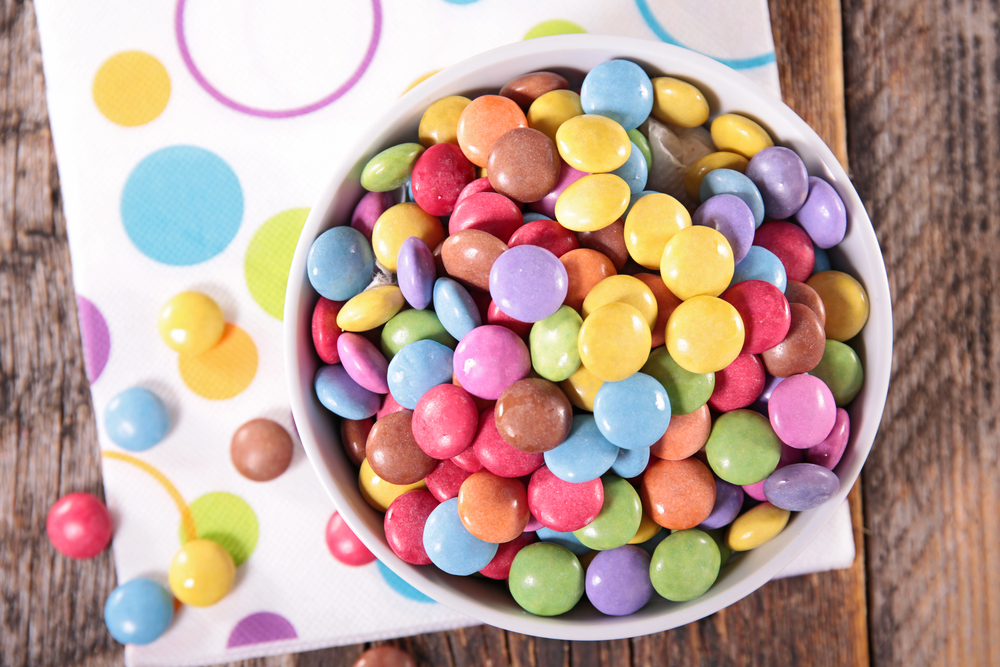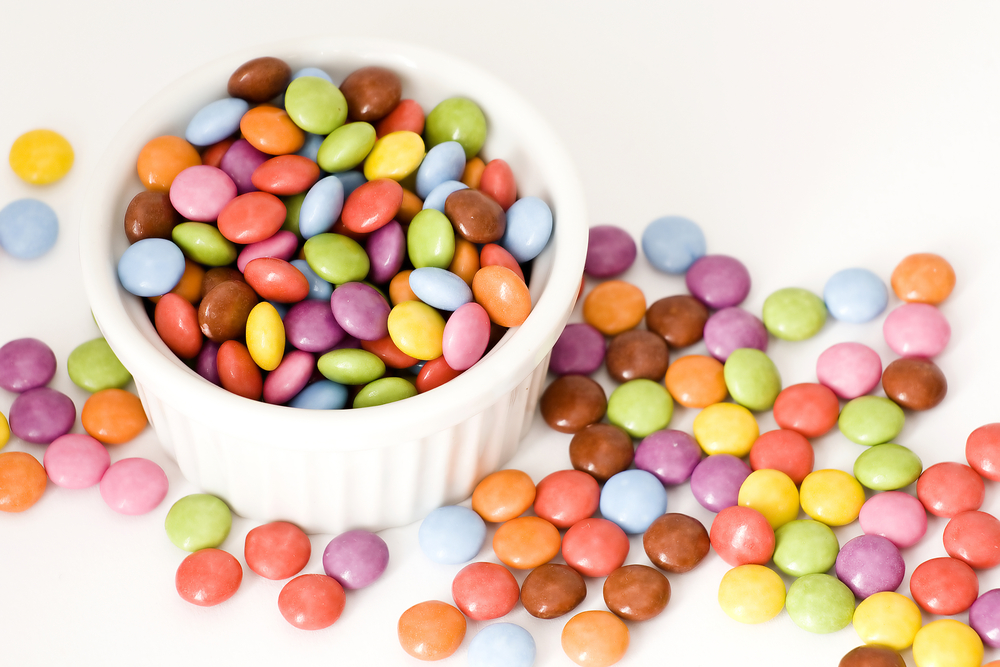In this article
Smarties are candies enjoyed in the US, UK, and Canada. They differ in each country, with the US version being sugar-based tablet candies and the UK and Canadian versions being sugar-coated chocolate beans. While the US version isn’t healthy for dogs, they are not poisonous. However, the UK and Canadian versions should never be given to dogs since they contain chocolate! In this article, we’ll look at both types of Smarties and see why the US type is safer if your pup eats one.

What Are Smarties?
Smarties sold in the US are round candies primarily made of a wheat or corn sugar derivative called dextrose, which is not toxic but not very healthy for dogs. In the UK and Canada, Smarties are milk chocolate beans coated in crunchy sugar shells, which are poisonous to dogs and should never be given to them to eat. Both types of Smartie come packaged in rolls or tubes and are sweet treats for humans, but taking a deeper look at the ingredients can help determine what makes them unhealthy for our dogs.

What Should I Do If My Dog Eats Smarties?
If your dog manages to wolf down Smarties when you’re not looking, your first moves will depend on the type of Smarties they’ve eaten and the amount. If your dog has eaten a couple of US Smarties, they may not experience any. However, keep an eye out for some minor gastrointestinal signs if they eat more than a couple, and contact your vet if you’re concerned.
If your dog has eaten any amount of UK or Canadian Smarties, contact your veterinarian for treatment. The effects of theobromine and caffeine can vary greatly depending on the size and weight of your dog, their general health, and the amount of Smarties eaten.
The veterinary treatment for chocolate toxicity usually involves making the dog vomit to clear them of the toxin and giving them activated charcoal to help mitigate the effects of any left in their system. In addition, supportive treatment from medications and intravenous fluids is sometimes needed, alongside close monitoring.
If you need to speak with a vet but can't get to one, head over to PangoVet. It's our online service where you can talk to a vet online and get the advice you need for your pet — all at an affordable price!
What Are the Ingredients in US Smarties?
In the US, Smarties are primarily made of dextrose and citric acid.
Dextrose
Dextrose is a starch sugar derived from corn or wheat refining that’s very similar to glucose (the sugar in the body). While dextrose isn’t a healthy foodstuff for your dog, it won’t harm healthy dogs if eaten in small amounts. If your dog is diabetic or has a large amount of dextrose, however, it can cause problems.
Citric Acid
Citric acid is a naturally-derived, harmless stabilizer used in several products (including dog food) in very small amounts. Citric acid can be found in citrus fruits and can cause mild gastrointestinal upset in dogs if large quantities are eaten. The amount found in Smarties is very unlikely to cause any problems.
Other Ingredients
Calcium stearate, colors, and flavorings are stabilizers and flavor enhancers, which won’t cause your dog any problems. The main concern with US Smarties is the effects on blood sugar a large amount of them may cause and the fact that gastrointestinal upset is likely to occur if your dog eats a whole bag! There are 6.9 grams of sugar (equivalent) in a roll of US Smarties, which is why they’re unhealthy for dogs to eat.

What About UK and Canadian Smarties Ingredients?
The difference between US and UK/Canadian Smarties is pretty big; Smarties in the UK and Canada are made with milk chocolate, which is very toxic to dogs. These Smarties should never be fed to dogs in any amount, and a visit to your veterinarian may be necessary if your dog has eaten any. The reason UK and Canadian Smarties are so bad for dogs is because of two substances found in chocolate that affect their bodies in a harmful way: theobromine and caffeine.

Theobromine
The Theobromine content in chocolate can vary, depending on the type. In milk chocolate, the type of chocolate in Smarties, there are 44 milligrams (mg) of theobromine per ounce. Theobromine negatively affects a dog’s central nervous system, respiratory system, and cardiovascular system, and as little as 9 ounces of baking chocolate can cause a toxic reaction in a 50-pound dog.
The signs of theobromine poisoning in dogs usually start with gastrointestinal distress like vomiting or diarrhea, with or without blood.
- Increased thirst
- Panting
- Ataxia
- Increased heart rate
- Seizures
- Heart failure
The signs of chocolate toxicity can take hours to occur, and it can take dogs days to recover from exposure to theobromine because it takes longer to clear from their bodies than it does in humans.

Caffeine
Caffeine is a stimulant found naturally in the Theobroma Cacao plant, or the plant from which all chocolate is made. Around 63 mg per pound of body weight is a toxic dose of caffeine, so the amount found in one Smartie is unlikely to be as much of an issue as theobromine is. However, it’s important to point out the signs of caffeine toxicity, as caffeine contributes to the danger that chocolate poses to our dogs.
- Vomiting and diarrhea
- Panting
- Hyperactivity and restlessness
- Tremors
- Seizures
There is around 20 mg of caffeine per 3½ ounces of milk chocolate. Apart from the chocolate, Smarties sold in the United Kingdom and Canada are coated in a crisp sugar shell, and each tube contains 10.7 grams of sugar. This is an unhealthy amount of sugar for any pet; your dog will be better off without it.
What Can I Give My Dog Instead of Smarties?
There are plenty of healthy, beneficial treats you can give your pup if they want something sweet to eat. Fruits, such as berries and stone fruit (with stone removed), are excellent treats for dogs in moderation. They are packed full of nutrients, vitamins, and fiber, and there is a large variety to keep your dog excited and happy. However, even fruit contains sugar, so don’t give your dog too much!
- Pineapple
- Blueberries/Raspberries
- Strawberries
- Pears

Final Thoughts
The United States has Smarties that resemble candy tablets, and the United Kingdom and Canada have chocolate-bean Smarties with candy shells. The dextrose-based US Smarties aren’t good for dogs but won’t harm them if only a few are eaten. Dogs cannot eat Smarties from the UK and Canada since they’re made with chocolate. Smarties, regardless of the type, should always be kept out of the reach of dogs and should never be given to them.
See also:
- Can Dogs Eat Nerds? Vet Reviewed Nutrition Facts
- Can Dogs Eat Jelly Beans? Vet-Verified Nutrition Facts & FAQ



















2 Responses
Why would any person subject their pet to animal abuse and cruelty by feeding it any sugar other than perhaps a few naturally occurring ones in their pet food? Have we lost our collective minds to think it is okay for a globe of people who are gorging themselves into diabetes to do the same to our pets when we feed them foods with added sugars and excessive fats and carbs such as many of the dog treats these days and daily feed as well?
Hello Angie,
thank you for your message. It is possible that people who feed their dogs sweets and excessive fats don't realize how harmful it can be for their dogs, same as many people don't realize how harmful are these ingredients for themselves.
We hope to improve the situation by shedding light on these issues and educating pet parents to know better. You can help by spreading our articles and information in them.
Have a great day!